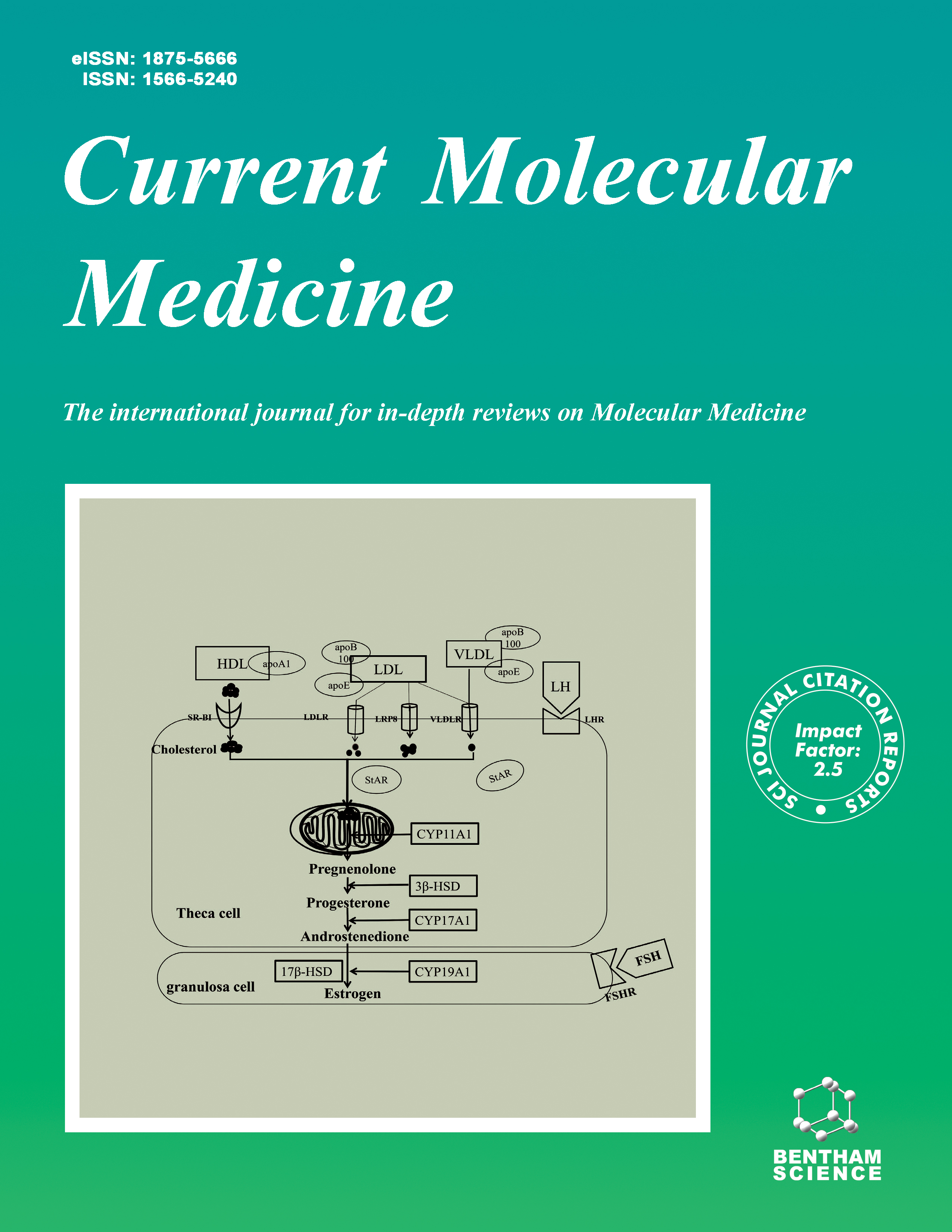- Home
- A-Z Publications
- Current Molecular Medicine
- Previous Issues
- Volume 1, Issue 3, 2001
Current Molecular Medicine - Volume 1, Issue 3, 2001
Volume 1, Issue 3, 2001
-
-
Role of the NF-kB Pathway in the Pathogenesis of Human Disease States
More LessAuthors: Y. Yamamoto and R.B. GaynorThe NF-kB family consists of a group of inducible transcription factors which regulate immune and inflammatory responses and protect cells from undergoing apoptosis in response to cellular stress. A number of signal transduction cascades can activate the NF-kB pathway to result in the translocation of the NF-kB proteins from the cytoplasm to the nucleus where they activate the expression of specific cellular genes. In th Read More
-
-
-
Molecular Characterization of the T Cell Repertoire Using Immuno-scope Analysis and its Possible Implementation in Clinical Practice
More LessAuthors: F. Ria, P. Elzen, L.T. Madakamutil, J.E. Miller, E. Maverakis and E.E. SercarzT lymphocytes play a central role in the pathogenesis of a large number of human conditions including autoimmunity and graft rejection. Although T cells are key players in mounting immune responses, the assessment of T cell repertoires has yet to find an important role in clinical decision making. In this review, we discuss the “immunoscope” technique and its potential diagnostic role in a variety of clinical scenarios. This is Read More
-
-
-
Alternative Routes for the Formation of Immunochemically Distinct Advanced Glycation End-products In Vivo
More LessAuthors: M. Takeuchi and Z. MakitaThe advanced stage of the glycation process (also called the “Maillard reaction”) that leads to the formation of advanced glycation end-products (AGEs) plays an important role in the pathogenesis of angiopathy in diabetic patients and in the aging process. AGEs elicit a wide range of cell-mediated responses that might contribute to diabetic complications, vascular disease, renal disease, and Alzheimer disease. Recently, it Read More
-
-
-
Molecular Steps of Tumor Necrosis Factor Receptor-Mediated Apoptosis
More LessBy S. GuptaUntil recently it was believed that TNF-induced apoptosis is mediated exclusively by TNF-RI because TNF-RII lacks death domain. However, it has been demonstrated that TNF-RII enhances TNF-RI-mediated apoptosis. In this review, I have discussed the evidence and mechanisms by which TNF-RII regulates TNF-alpha-induced apoptosis. A role of RIP is emphasized and novel mechanisms of FLIP-mediated inhibition of apoptosis a Read More
-
-
-
Gene Therapy for Diabetes Mellitus
More LessBy T. YamaokaThere are diverse strategies for gene therapy of diabetes mellitus. Prevention of beta-cell autoimmunity is a specific gene therapy for prevention of type 1 (insulin-dependent) diabetes in a preclinical stage, whereas improvement in insulin sensitivity of peripheral tissues is a specific gene therapy for type 2 (non-insulin- dependent) diabetes. Suppression of beta-cell apoptosis, recovery from insulin deficiency, and relief of diabetic c Read More
-
-
-
Mechanisms of T Cell Receptor Antagonism: Implications in the Treatment of Disease
More LessBy B.N. DittelThe adaptive immune response is often required for the successful clearing of infectious pathogens. Antigen presenting cells (APC) present peptide antigens derived from pathogens to T cells via major histocompatibility complex (MHC) molecules. T cells then become activated and differentiate into effector cells with the capacity to kill infected cells or to induce an anti-pathogen antibody response. In autoimmunity, this T cell res Read More
-
-
-
Insights into the Pathogenesis of Type 1 Diabetes A Hint for Novel Immunospecific Therapies
More LessAuthors: S. Casares and T-D. BrumeanuType 1 diabetes is an organ-specific autoimmune disease whose incidence is increasing worldwide. At present, there is no effective therapy to prevent or cure this disease. The genetic background (MHC and non-MHC genes) and environmental factors (pathogens, drugs, and diet) are critical for the initiation of the autoimmune response against the pancreatic beta-cells. Recognition of the pancreatic autoantigens by T Read More
-
-
-
Pediatric Autoimmune Liver Diseases The Molecular Basis of Humoral and Cellular Immunity
More LessAuthors: L. Wen, Y. Ma, D.P. Bogdanos, F. Wong, A. demaine, G. Mieli-Vergani and D. VerganiPediatric autoimmune liver disease is mainly represented by two similar liver disorders autoimmune hepatitis (AIH) and autoimmune sclerosing cholangitis (ASC), both characterized by hypergammalobulinemia, interface hepatitis and the presence of a wide range of circulating autoantibodies. Although similar features are seen in AIH and inflammatory bowel disease, histological biliary changes are more commo Read More
-
-
-
Directed Gene Modification via Triple Helix Formation
More LessAuthors: L. Gorman and P.M. GlazerThe ability to selectively target mammalian genes and disrupt or restore their function would represent an important advance in gene therapy. Mutation of a single nucleotide can often result in a non-functional gene product. Reversion of defective genes to their correct sequences could lead to permanent cures for patients with many genetic diseases. Molecules such as triplex forming oligonucleotides (TFOs) and peptide Read More
-
Volumes & issues
-
Volume 25 (2025)
-
Volume 24 (2024)
-
Volume 23 (2023)
-
Volume 22 (2022)
-
Volume 21 (2021)
-
Volume 20 (2020)
-
Volume 19 (2019)
-
Volume 18 (2018)
-
Volume 17 (2017)
-
Volume 16 (2016)
-
Volume 15 (2015)
-
Volume 14 (2014)
-
Volume 13 (2013)
-
Volume 12 (2012)
-
Volume 11 (2011)
-
Volume 10 (2010)
-
Volume 9 (2009)
-
Volume 8 (2008)
-
Volume 7 (2007)
-
Volume 6 (2006)
-
Volume 5 (2005)
-
Volume 4 (2004)
-
Volume 3 (2003)
-
Volume 2 (2002)
-
Volume 1 (2001)
Most Read This Month
Article
content/journals/cmm
Journal
10
5
false
en


